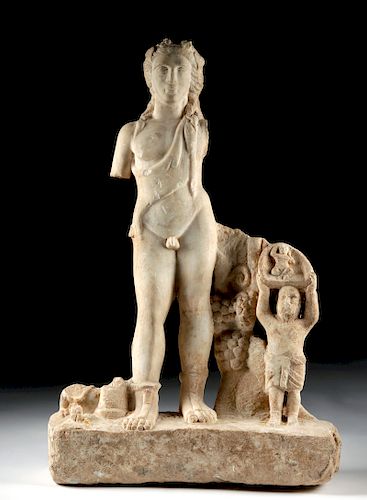Roman Marble Relief with Dionysus, Silenus, & Child
Lot 56c
About Seller
Artemis Fine Arts
686 S Taylor Ave, Ste 106
Louisville, CO 80027
United States
Selling antiquities, ancient and ethnographic art online since 1993, Artemis Gallery specializes in Classical Antiquities (Egyptian, Greek, Roman, Near Eastern), Asian, Pre-Columbian, African / Tribal / Oceanographic art. Our extensive inventory includes pottery, stone, metal, wood, glass and textil...Read more
Estimate:
$15,000 - $25,000
Absentee vs Live bid
Two ways to bid:
- Leave a max absentee bid and the platform will bid on your behalf up to your maximum bid during the live auction.
- Bid live during the auction and your bids will be submitted real-time to the auctioneer.
Bid Increments
| Price | Bid Increment |
|---|---|
| $0 | $25 |
| $300 | $50 |
| $1,000 | $100 |
| $2,000 | $250 |
| $5,000 | $500 |
| $10,000 | $1,000 |
| $20,000 | $2,500 |
| $50,000 | $5,000 |
| $100,000 | $10,000 |
| $200,000 | $20,000 |
About Auction
By Artemis Fine Arts
Feb 21, 2019
Set Reminder
2019-02-21 10:00:00
2019-02-21 10:00:00
America/New_York
Bidsquare
Bidsquare : Exceptional Antiquities, Asian, Ethnographic
https://www.bidsquare.com/auctions/artemis-gallery/exceptional-antiquities-asian-ethnographic-3858
An important one-day auction featuring museum-worthy examples of Egyptian, Greek, Roman, Etruscan, Near Eastern, Far East / Asian, Pre-Columbian, African / Tribal, Oceanic, Native American, Spanish Colonial, Russian, Fossils, Ancient Jewelry, Fine Art, so much more! Artemis Fine Arts info@artemisfinearts.com
An important one-day auction featuring museum-worthy examples of Egyptian, Greek, Roman, Etruscan, Near Eastern, Far East / Asian, Pre-Columbian, African / Tribal, Oceanic, Native American, Spanish Colonial, Russian, Fossils, Ancient Jewelry, Fine Art, so much more! Artemis Fine Arts info@artemisfinearts.com
- Lot Description
Roman, Imperial Period, ca. 2nd to 4th century CE. Carved from a creamy, white marble, this is an interesting sculpture depicting two stages of the life of one of the most popular gods of the Roman pantheon, Dionysus (Bacchus). The main figure is a standing depiction of the god as an adult - handsome, youthful, and nude aside from sandals and a sash across the body. His muscular legs and chest as well as his genitals are carefully carved, creating a sensuous, lifelike portrait. His head and face are large, with big eyes, an expressionless mouth, and a small nose. His face is framed by curled hair parted at the center, and a garland is visible at the top of his head. Beside him is a grapevine with three large clusters of grapes on it; hints of architectural details are visible to either side of the god, including the bases of possibly two columns. Low and on one side is a figure of a bearded man wearing a loincloth and holding up a baby inside a basket - probably meant to be Silenus and perhaps baby Dionysus himself. Size: 5.25" L x 16" W x 25.75" H (13.3 cm x 40.6 cm x 65.4 cm)
The sculptural details present here are fantastic - particularly of the grape clusters and the god's clothing and sandals with perfectly lifelike toes. Interestingly, the god is also sculpted on the back, with details of his body and clothing nicely carved. The other figures are not carved on the back - so the god may have been at the end of a relief, while the figure of Silenus and child were part of a relief.
Although Dionysus and his followers like Silenus appear on classical Greek pottery - usually on vessels for wine - they first became popular in sculpture in the Hellenistic period, when many of the conventions of portraying them became codified. The visual clues to this sculpture's identity come from comparison with other portrayals of Dionysus - see, for example, the 2nd century Roman statues of the god that are after Hellenistic originals and are now held in the Louvre and Prado, where the hair and headdress are very similar. Silenus holding the child Dionysus - son of Zeus and a human woman, Semele - is also a motif known from classical artwork. For example, there is a Roman marble copy of a Greek original sculpture by Lysippos (ca. 300 BCE) that depicts the bearded god cradling the child.
Dionysus's popularity in sculpture only grew in Imperial Rome. The wealthy people who could commission marble statuary were attracted to him for many reasons, aside from just being the god of pleasure - his half-mortal form, his magnificent lifestyle, and the possibility that he could be an ancestor of their own. From the 2nd century onward, scenes of Dionysus and his entourage crowded the tombs of the Roman elite - likely where this panel originated.
See a similar sculpture that sold at Christie's London in 2013 for GBP 31,250 (approximately $45,000 USD): https://www.christies.com/lotfinder/ancient-art-antiquities/a-roman-marble-dionysus-circa-2nd-century-5673377-details.aspx?from=searchresults&intObjectID=5673377&sid=b1fbcd4a-297c-4b05-a9ef-050b536c767a
Provenance: private East Coast, USA collection; ex-Frances Artuner collection, Belgium, acquired in the 1960s
All items legal to buy/sell under U.S. Statute covering cultural patrimony Code 2600, CHAPTER 14, and are guaranteed to be as described or your money back.
A Certificate of Authenticity will accompany all winning bids.
We ship worldwide and handle all shipping in-house for your convenience.
#143895Piece is a fragment as shown. Much of the main figure remains aside from the arms and part of the hair/headdress. Silenus is in nice condition. The grapevine behind is partially lost. Wear on surface commensurate with age, including small scratches and chips. Deposits on surface as shown.Condition
- Shipping Info
-
All shipping is handled in-house for your convenience. Your invoice from Artemis Gallery will include shipping calculation instructions. If in doubt, please inquire BEFORE bidding for estimated shipping costs for individual items.
-
- Buyer's Premium



 EUR
EUR CAD
CAD AUD
AUD GBP
GBP MXN
MXN HKD
HKD CNY
CNY MYR
MYR SEK
SEK SGD
SGD CHF
CHF THB
THB














